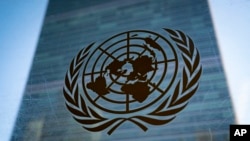The U.N.’s premiere global body fighting for gender equality on Saturday called for wide-ranging efforts to close the gap between men and women in today’s technology-driven world and urged zero tolerance for gender-based violence and harassment online.
In a document approved by consensus after all-night negotiations at the end of a two-week meeting, the Commission on the Status of Women expressed grave concern at the interrelation between offline and online violence, harassment and discrimination against women and girls — and it condemned the increase in these acts.
It called for a significant increase in investments by the public and private sector to bridge the gender digital divide. It also called for the removal of barriers to equal access to digital technology for all women and girls, and new policies and programs to achieve gender parity in emerging scientific and technological fields.
Sima Bahous, executive director of UN Women, an entity of the United Nations focusing on gender equality and the empowerment, called the document “game-changing” in promoting a blueprint for a more equal and connected world for women and girls. The challenge now, she said, is for governments, the private sector, civil society and young people to turn the blueprint “into reality for all women and girls.”
At the start of the commission’s two-week meeting, U.N. Secretary-General Antonio Guterres said its focus was very timely because women and girls are being left behind as technology races ahead.
“Three billion people are still unconnected to the internet, the majority of them women and girls in developing countries, [and] in least developed countries just 19% of women are online,” Guterres said. “Globally, girls and women make up just one-third of students in science, technology, engineering and mathematics” and men outnumber women two to one in the tech industry.
Bahous told the opening meeting that “the digital divide has become the new face of gender inequality,” with 259 million more men than women online last year. She also cited a survey of female journalists from 125 countries that found three-quarters had experienced online harassment in the course of their work and a third had engaged in self-censorship in response.
The “agreed conclusions” document adopted Saturday by the 45-member commission calls for equal quality education for women and girls in science, technology, engineering, mathematics, information and communications technology, and digital literacy so they can thrive in the rapidly changing world.
During lengthy negotiations on the document, which has 93 paragraphs, U.N. diplomats said language on women’s rights was challenged by Russia, Indonesia, Malaysia and the Holy See and human rights language was also challenged by those countries as well as Cuba and China. There were also intense debates over language on gender-based violence facilitated by technology, they said, speaking on condition of anonymity because negotiations were closed.
The final document reaffirms the 1995 Beijing platform adopted by 189 countries which said for the first time in a U.N. document, that women’s human rights include the right to control and decide “on matters relating to their sexuality, including their sexual and reproductive health, free of discrimination, coercion and violence.”
The final issue blocking consensus was Pakistan’s insistence on adding a reference to “foreign occupation” to the document, and Israel’s strong opposition, diplomats said. The reference was not included and before the document’s adoption Pakistan’s representative expressed regret that the needs and priorities of women belonging to developing countries and facing humanitarian crisis including foreign occupation were not included.







